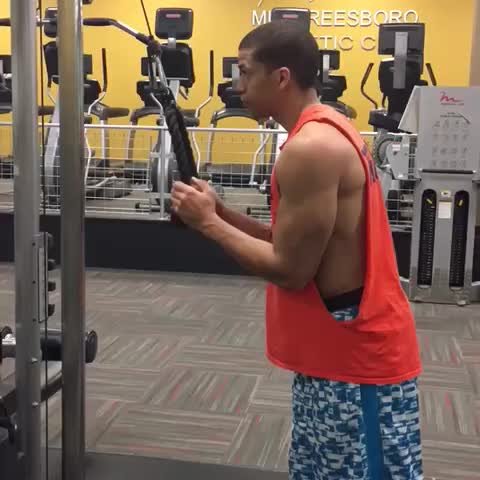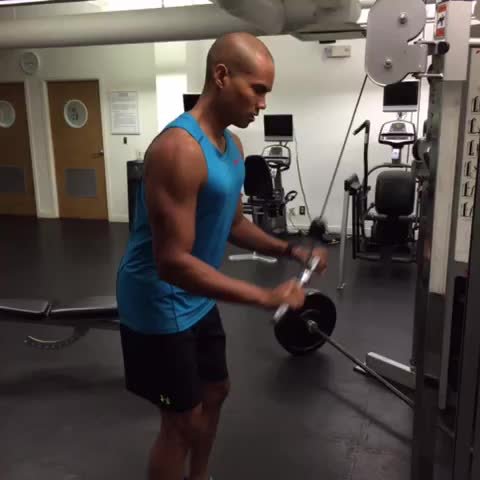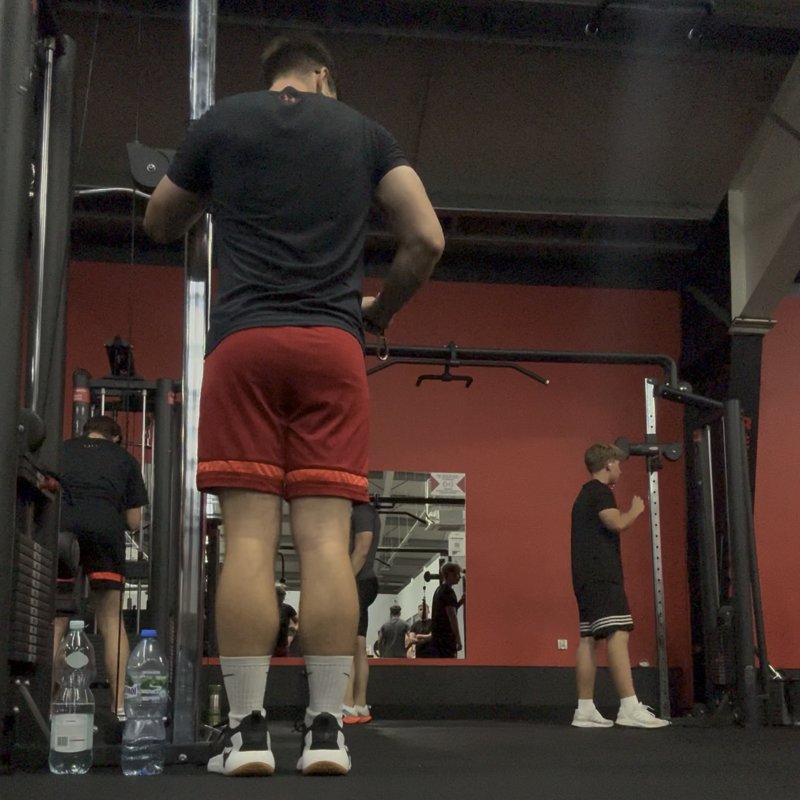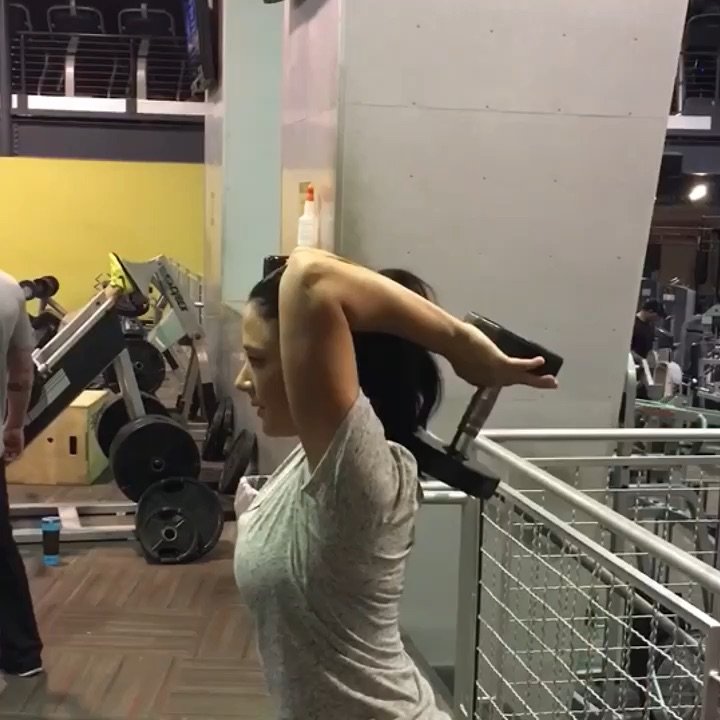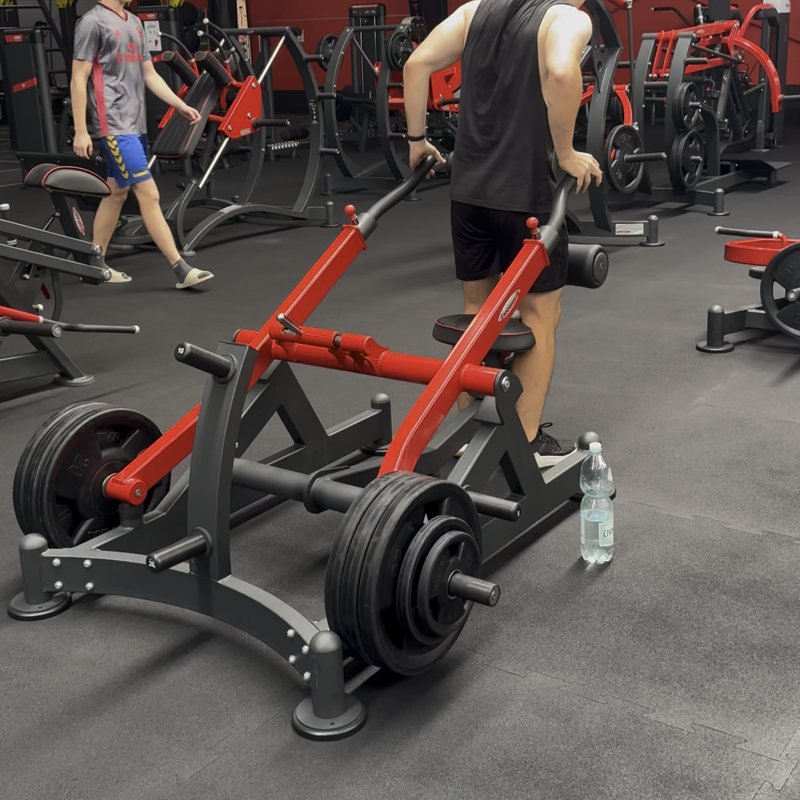Overhead Tricep Cable Extension: The Ultimate Guide
The Overhead Tricep Cable Extension is an isolation exercise that effectively targets all three heads of the triceps muscle, with particular emphasis on the long head, to build arm size, strength, and definition.
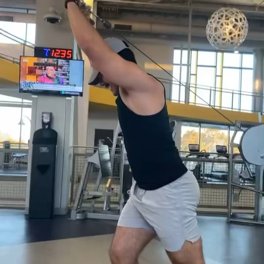
Quick Facts
Key Benefit
Long head tricep development and arm definition
Primary Muscles
Triceps
Secondary Muscles
Abdominals, Posterior Deltoids, Traps
Equipment
cable machine
Difficulty
Beginner
Type
Strength
In This Guide
Ready to master the Overhead Tricep Cable Extension?
Track your progress, see improvements over time, and build strength consistently.
Download GravitusThe Overhead Tricep Cable Extension is one of the most effective exercises for isolating and developing the triceps, particularly the long head. This exercise utilizes a cable machine to provide constant tension throughout the movement, making it superior to many free-weight alternatives for hypertrophy-focused training. The triceps brachii makes up approximately two-thirds of your upper arm mass and consists of three heads: the lateral (outer), medial (inner), and long head. While all three heads work together to extend the elbow, the long head is unique because it crosses the shoulder joint. This means it's most effectively stretched and activated when the arm is positioned overhead during extension movements. The cable component of this exercise offers a significant advantage by maintaining consistent resistance throughout the entire range of motion, keeping tension on the triceps even at the top of the movement where free weights might reduce the challenge due to changing leverage. Whether your goal is to increase arm size, improve pressing strength for compound movements like bench press and overhead press, or enhance the aesthetic "horseshoe" appearance of well-developed triceps, the Overhead Tricep Cable Extension deserves a place in your training program.
Benefits of Overhead Tricep Cable Extensions
This exercise offers several unique advantages for triceps development and overall arm training.
Long Head Emphasis
The overhead position specifically targets the long head of the triceps, which is often undertrained in many pushing exercises but crucial for complete arm development.
Constant Tension
Unlike free weights, the cable provides consistent resistance throughout the entire movement, keeping the triceps engaged even at the starting position.
Joint-Friendly
The cable's smooth resistance curve and adjustable positions typically make this exercise more comfortable for those with elbow issues compared to some free-weight variations.
Effective Isolation
The fixed pulley position helps eliminate momentum and body english, ensuring the triceps do the work rather than secondary muscles.
Growth Potential
The focused tension and complete range of motion stimulate both mechanical tension and metabolic stress, two key drivers of muscle hypertrophy.
Proper Form & Technique
Setup
- Attach a rope handle (or your preferred attachment) to a high cable pulley.
- Face away from the cable machine with feet shoulder-width apart or in a split stance for stability.
- Grasp the rope with both hands, palms facing each other in a neutral grip.
- Step forward to create tension on the cable and establish your position.
- Raise your arms overhead, keeping the upper arms close to your head and ears.
- Begin with elbows bent at approximately 90 degrees, with the rope positioned behind your head.
- Engage your core and maintain a neutral spine with minimal arching in your lower back.
Movement
- Keeping your upper arms stationary and close to your head, exhale as you extend your forearms upward by contracting your triceps.
- Focus on moving only at the elbow joint while maintaining position of your shoulders and upper arms.
- Continue extending until your arms are fully straightened overhead (avoid locking out the elbows completely).
- At the top of the movement, squeeze your triceps for a moment to maximize contraction.
- Inhale as you slowly control the return movement, allowing the weight to flex your elbows and lower the rope back behind your head.
- Lower until you feel a stretch in your triceps, typically when your forearms approach parallel to the floor.
- Maintain tension throughout the movement—don't let the weight stack touch down between repetitions.
- Repeat for the desired number of repetitions, maintaining form and control throughout.
Key Form Tips
Upper Arm Position
Keep your upper arms stationary and close to your head throughout the entire movement to maximize triceps isolation.
Elbow Position
Keep elbows pointing forward rather than flaring outward to optimize triceps engagement and reduce shoulder stress.
Range of Motion
Lower the attachment until you feel a good stretch in your triceps, then extend fully without locking out the elbows.
Spine Alignment
Maintain a neutral spine position—avoid excessive arching of the lower back, which can occur when using too much weight.
Control
Focus on slow, controlled movement, especially during the eccentric (lowering) phase to maximize muscle stimulation.
Muscles Worked
Primary Muscles
- triceps: The three-headed muscle on the back of the upper arm consisting of the long head (innermost), lateral head (outer), and medial head (inner). The overhead position places particular emphasis on the long head, while all three heads work together in elbow extension to create the pushing action.
Secondary Muscles
- anconeus: A small muscle near the elbow that assists with elbow extension and stabilization during the movement.
- posterior deltoids: The rear portion of the shoulder muscle works isometrically to help maintain the overhead arm position.
- abdominals: The abdominals, obliques, and lower back stabilizers work to maintain proper posture during the standing exercise.
- traps: The upper and middle fibers assist in stabilizing the shoulder blades during the overhead position and movement.
Common Mistakes and How to Fix Them
Moving the Upper Arms
Allowing the upper arms to move forward or backward during the exercise reduces triceps isolation. Fix this by keeping your upper arms fixed alongside your head throughout the movement, focusing solely on elbow extension. If needed, use a mirror to monitor arm position or consider reducing the weight until you can maintain proper form.
Excessive Arching of the Lower Back
Arching the back can occur when using too much weight or poor core engagement. Brace your core muscles throughout the movement and consider using a split stance for greater stability. If back arching persists, reduce the weight or try the exercise in a seated position to eliminate the lower back compensation.
Using Momentum
Swinging the weight or using body movement makes the exercise less effective and increases injury risk. Focus on controlled, deliberate movement with a moderate tempo—perhaps a 2-second extension and 3-second return. Select a weight that allows you to perform the movement strictly with triceps power rather than momentum.
Incomplete Range of Motion
Not lowering the weight sufficiently or not extending fully reduces effectiveness. Ensure you lower the attachment until you feel a good stretch in your triceps (typically when forearms approach parallel to the floor) and extend fully without completely locking out the elbows. Use a lighter weight if necessary to achieve the full range of motion.
Flaring Elbows
Allowing elbows to drift outward reduces long head engagement and can stress the shoulders. Keep your elbows pointing forward and relatively close to your head throughout the exercise, maintaining a narrow path of movement. Practice this position with lighter weight until it becomes natural before progressing to heavier loads.
Exercise Variations
Attachment Variations
-
Straight Bar Overhead Extension
Using a straight bar attachment instead of rope for a fixed hand position that some find creates stronger triceps activation.
-

V-Bar Overhead Extension
Utilizing a V-shaped bar that provides a neutral grip position while keeping hands in a fixed position throughout the movement.
-
Single Handle Overhead Extension
Performing the exercise with a single D-handle attachment for one arm at a time, allowing greater focus on each individual triceps.
Position Variations
-

Seated Overhead Cable Extension
Performing the exercise while seated on a bench for increased stability and potentially greater isolation of the triceps.
-

Kneeling Overhead Cable Extension
Executing the movement from a kneeling position to minimize lower body involvement and enhance core stabilization.
-

Split Stance Overhead Extension
Using a staggered foot position to provide greater stability and balance during the standing variation.
Technical Variations
-

Overhead Extension with Hold
Adding a 2-3 second isometric hold at the point of full extension to increase time under tension and maximize contraction.
-

Pulse Overhead Extension
Performing small, partial-range pulses at full extension to intensify the peak contraction phase.
Frequently Asked Questions
Most people achieve optimal results training triceps 2-3 times per week with at least 48 hours between sessions focusing on the same muscle group. The Overhead Tricep Cable Extension can be included in upper body push days, arm-specific workouts, or full-body training sessions. If you're training triceps multiple times weekly, consider varying the exercises, rep ranges, and intensities between sessions to provide different stimuli. For example, you might use the overhead cable extension for higher reps (12-15) in one session and a different triceps exercise for lower reps (6-8) in another session. Your individual recovery capacity, training experience, and overall program design will influence the optimal frequency. Watch for signs of overtraining like persistent soreness, decreased performance, or joint discomfort, which would suggest you need more recovery time between triceps-focused sessions.
Generally, it's most effective to perform compound movements (like bench press, overhead press, or dips) before isolation exercises like the Overhead Tricep Cable Extension. This approach allows you to devote maximum energy to the multi-joint exercises that build overall strength and move the most weight. However, program design depends on your specific goals. If triceps are a lagging muscle group that you're prioritizing, occasionally performing this exercise first in your workout can provide a novel stimulus. Another effective approach is pre-exhaustion, where you perform the overhead extension before pressing movements to specifically challenge the triceps during the compound exercises. This technique can increase triceps activation during presses but will reduce the total weight you can handle on those movements. For general development, perform overhead extensions after your main pressing work; for specific triceps focus phases, experiment with different exercise sequencing to determine what produces the best results for your particular goals.
Neither exercise is inherently "better"—they emphasize different aspects of triceps development and complement each other effectively. The Overhead Tricep Cable Extension places particular emphasis on the long head of the triceps due to the stretched overhead position at the shoulder joint. Tricep pushdowns tend to emphasize the lateral and medial heads more effectively. For complete triceps development, incorporating both movement patterns is ideal. If your triceps lack overall size, the overhead extension might be prioritized due to its emphasis on the long head (the largest of the three). If you have elbow issues, some people find pushdowns more comfortable than overhead movements, while others experience the opposite. The most effective approach is to include both exercise types in your training program—either within the same session (perhaps starting with the overhead variation when you're fresh) or alternating between them in different workouts throughout the week.
Yes, you can effectively perform this exercise with a straight bar, V-bar, or rope attachment—each offering slightly different benefits. The rope attachment allows your hands to separate slightly at the top of the movement, potentially enabling a slightly stronger contraction and more natural wrist position throughout the range of motion. The straight bar provides a fixed hand position that some lifters find creates stronger triceps activation due to the pronated (palms-down) grip. The V-bar offers a middle ground with a neutral grip position while keeping hands in a fixed width. Your choice should be based on comfort, mind-muscle connection, and wrist/elbow health. Many experienced lifters rotate between different attachments across training sessions to provide varied stimuli to the muscles. If you experience any discomfort with a particular attachment, especially at the wrists or elbows, try alternatives to find what works best for your individual biomechanics. There's no single "correct" attachment—the best one is the one that allows you to effectively target your triceps without joint discomfort.
Video Demonstrations
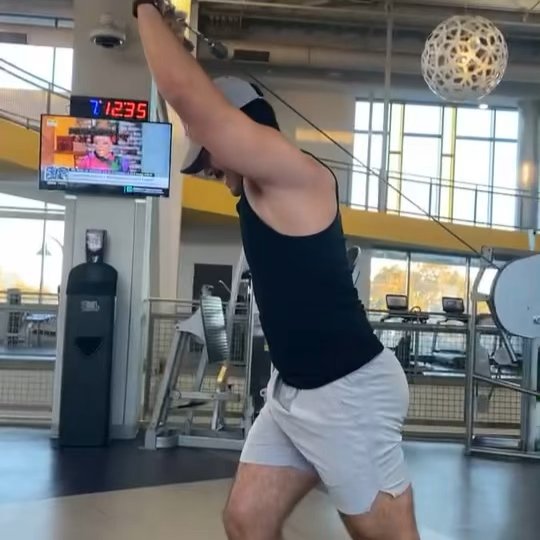
Log in to watch video demonstrations
Login to Watch3 video demonstrations available
Track your progress with Gravitus
Download Gravitus to log your workouts, track your progress, and join a community of fitness enthusiasts.

Helpful Resources
One Rep Max Calculator
Find your one rep max for any exercise without maximal testing. Essential for developing effective strength training programs.
Calculate 1RMWorkout Programs
Follow structured workout programs created by fitness professionals to maximize your strength and muscle gains.
View Programs